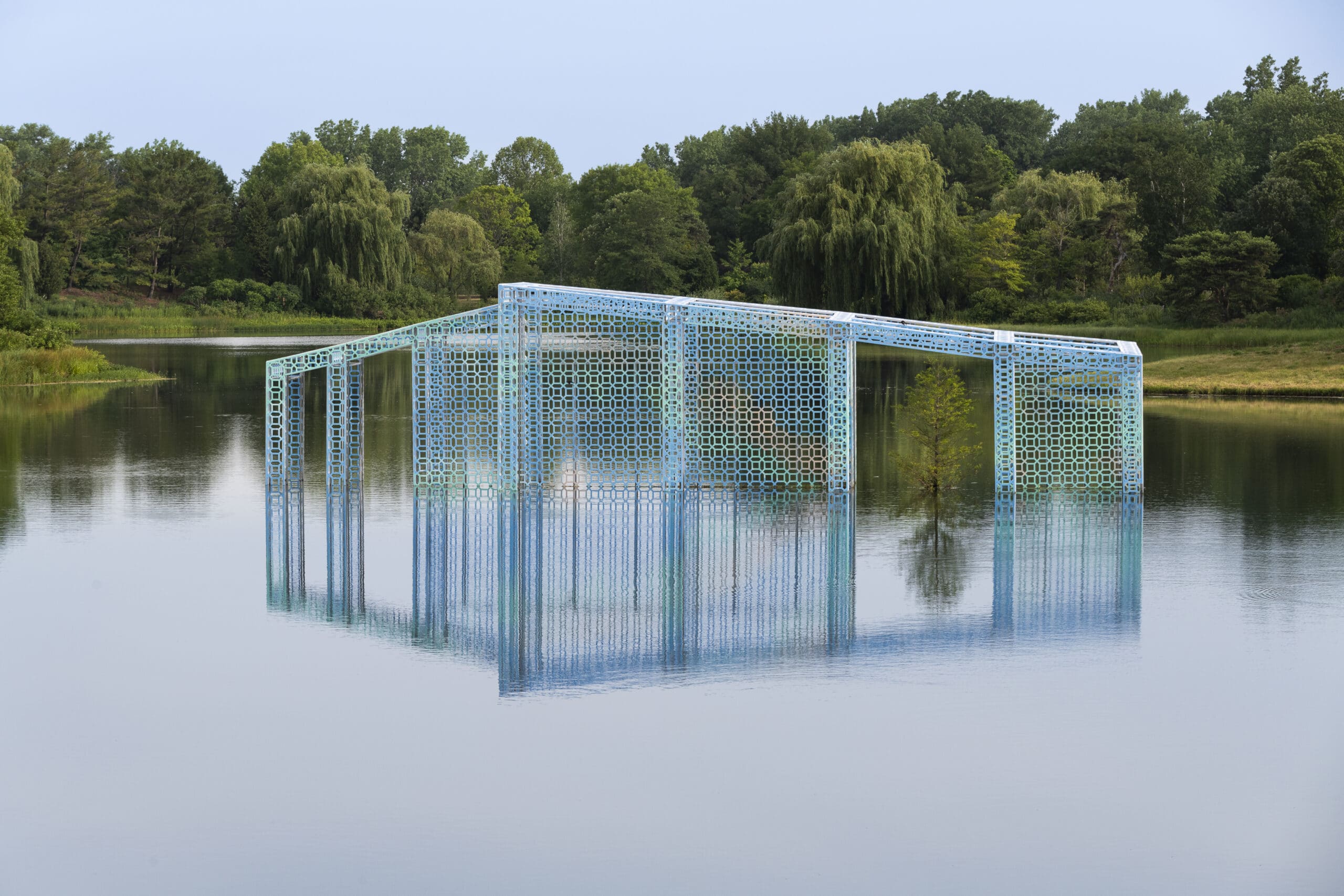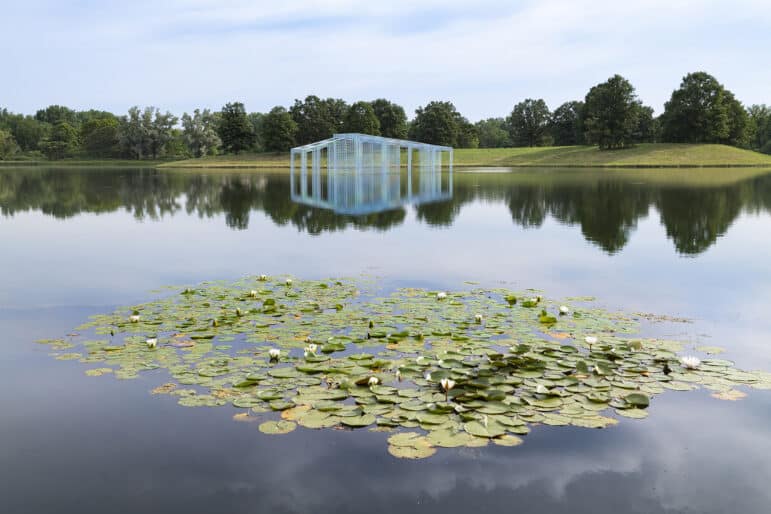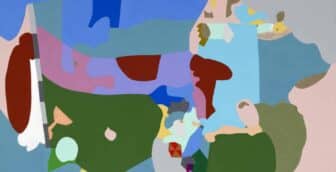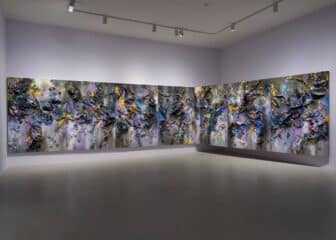
Casa-Isla/House-Island: Edra Soto’s Reimagining of Insularity

Edra Soto’s Casa-Isla/House-Island stood in a body of water at the Chicago Botanic Garden like a mirage or hallucination from May 13 to September 25, 2022.1 Casa-Isla/House-Island calls to mind the words of philosopher María Zambrano, who, in her essay “Isla de Puerto Rico (Nostalgia y Esperanza de un Mundo Mejor)” [“Island of Puerto Rico (Nostalgia and Hope for a Better World)”], reflects on the island as “the residue of something, the trace of a better world, of a lost innocence.”2 Seen from above, the outline of Casa-Isla/House-Island—positioned thirty feet from public view in the center of an artificial lagoon and crafted from Sintra, aluminum tubing, pressure-treated wood, and latex paint—resembles the silhouette of the Puerto Rican archipelago, with its blue-green tones reflecting the vibrant colors of the Caribbean waters. These hues allow it to blend seamlessly with the sky and clouds, creating the illusion of a celestial house that evokes memories of another reality and embodies a dreamy lightness. Those who admire it seem to be in motion, while the houses of the past accompany them like mirages, confirming their reflections on the lake’s surface.
The work was positioned in our present context when comedian Tony Hinchcliffe, at a Donald Trump rally held in New York City—which has the largest population of Puerto Ricans outside the island—xenophobically described Puerto Rico as a “floating island of garbage.”3 What does Soto, a Puerto Rican artist, evoke with her transparent and ethereal house? What to make of the structure that floats in the calm of a man-made lagoon, sited in Chicago, which also has a sizable Diasporican community? What do the blue, celestial cavities of this residence convey amidst the presence of over five million Puerto Ricans living in the continental United States, many of whom share the experience of displacement? While editing my poetry collection, A History of Cuban Poets, As Told by Their Houses, I found myself captivated by Soto’s work. Having faced the loss of my own family home in Cuba, and as a Cuban American poet, I recognized in her work a poignant expression of the homesickness that I, along with countless other writers, carry deep within.
Soto, an artist and educator born in Puerto Rico and based in Chicago, revisits through Casa-Isla/House-Island the urgent realities of the Puerto Rican people as well as those of other Caribbean diasporas. This includes displacement, transplantation, and the consequent loss of home—not only as a physical residence, but also as a representation of family ties to ancestors. As the Puerto Rican scholar Juan Flores reminded us, perhaps the principal cultural consequence of transnational diaspora life “is that [it] necessarily stretches the meaning of national belonging by disengaging it from its presumed territorial and linguistic imperative.”4 The fact that the concepts of house and island are linked by the bridge of the hyphen inevitably refers to this instability. Envisioned as a work to be admired from a distance, Casa-Isla/House-Island invites reflection on a metaphorical journey of returning to Puerto Rico while acknowledging that some synesthetic experiences remain forever beyond reach for those who have departed. In this essay, I analyze Soto’s work as an artistic alternative that reimagines the concept of insularity.
Casa-Isla/House-Island offers a dreamlike vision of a Caribbean archipelago—one that is rooted, yet is portable and transportable—constructing an insular space that reframes the aquatic condition surrounding the island as an opportunity to reconnect and to discover, as Puerto Rican poet Julia de Burgos mentions in her well-known poem “Río Grande de Loíza”: “¡Quién sabe en qué aguacero de qué tierra lejana/me estaré derramando para abrir surcos nuevos;/o si acaso, cansada de morder corazones,/me estaré congelando en cristales de hielo.” [“Who knows in what downpour from what distant land/I will be pouring myself out to open new furrows;/or if perhaps, tired of biting hearts,/I will be freezing into ice crystals.”]5
Being part of this tradition of Puerto Rican and Caribbean diaspora, Soto designed a raft that allowed the structure to float in the artificial lagoon. After observing the colors of the garden, Soto selected a palette for the surface that, surprisingly, was similar to the colors in Claude Monet’s water lily paintings.6 Reinterpreting the octagonal and square designs commonly found in the decorative patterns of quiebrasoles—brise-soleil typical of mid-twentieth-century Puerto Rican architecture and a recurrent form in her work—Soto created a transparent house where the concept of domestic privacy becomes an illusion. This residence is open to fresh air and visibility, challenging the island’s heat and embracing the exposure of its interiors. When viewed from a distance, the seemingly empty structure can evoke nostalgic memories associated with that pristine living space, which Gaston Bachelard likens to “our first universe, a real cosmos in every sense of the word.”7 Soto’s Casa-Isla/House-Island transforms into a powerful reminder full of selective memories. The geometric openings that allow light and wind to flow through also let in reminiscences of familiar scenes and situations. A longing arises from a sense of loss that intersects with Soto’s invitation—not only to remember the lost house but also to dream of another possible one. In earlier works from the “GRAFT” series, which she began in 2012, Soto included snapshots of life on the island—made during her visits when she documented changes in the landscape after hurricanes—into the gaps of rejas (wrought-iron bars and gates) and quiebrasoles, incorporating both photography and sculpture.8 Now, Soto interacted with the flora in innovative ways at the Chicago Botanic Garden, which, as requested, lent a shrub to occupy a specially designed space for the plant to thrive in the Casa-Isla/House-Island. The artist has substituted the human element from the “GRAFT” series with a more-than-human entity, certainly maintaining a connection to the sense of loss and sorrow, but also with rebirth: the shrub, given to her as “bare bones,” flourished during the exhibition, an element that Soto understood “as the beating heart of the sculpture.”9

Casa-Isla/House-Island invites viewers to fill its openings with objects or images that have been lost in the ongoing shipwrecks of various diasporas, through a variation of roles in which the protagonist of the sculpture is a nascent tree that emerges, like the islands, from the waters. Its concept of insularity transitions into a form of transnational cosmopolitanism: the physical distance between Puerto Rico and other landmasses creates conditions that facilitate the fluidity of movement and connection with others. As Flores continues highlighting, “the very notion of ‘home’ under conditions of globalization is dismissed as essentialist and illusory nostalgia.”10 In this context, Soto recognizes the importance of allowing viewers to make and maintain their own notion of home and invites us into the illusion of a house that is open to the world, thus enabling everyone to create a place of rest and solace that has been denied to them.
The Casa-Isla/House-Island serves as a complex habitat with multiple dimensions. On one level, it draws inspiration from the traditional Taíno bohío lacustre—structures built on stilts to endure the fierce onslaught of hurricanes.11 On another level, it asserts its presence even when faced with damage. Finally, the house reflected in the stillness of the water represents an ephemeral existence, poised to vanish—standing strong one day and devastated the next. This is a metaphor for the environmental catastrophes that have long afflicted Puerto Rico, which persistently endanger the well-being of its inhabitants. Such traumatic natural and human-made disasters often lead to mass migrations, which was particularly evident after the crushing impact of Hurricane María in 2017. In many ways, Soto’s house becomes an island because, as Zambrano explains, the island “is a place where we retreat when the spectacle of the world around us threatens to erase all images of human nobility.”12 We escape to this enclosure of light and constant breezes that Soto erects not as an act of evasion, but of contemplative resistance, accepting even the dangers and pressure of the ephemeral. One might even argue that the hollowed-out house is, in a sense, a ruin—something that has endured despite various emotional, social, political, and environmental challenges. The artist reclaims the spirituality of the ancestral home built by her forebears, intended to be passed down through generations. However, this cycle of family continuity has been disrupted by diasporic events. Perhaps due to this contradiction, the only house that Soto can envision as a response to the loss of the original home is this alternative version, crafted from shades of blue and from winds rising from the waters, mirroring the emergence of the islands.

What can we hope for when we have lost that first home, which at times feels like an island, a refuge, or a decaying remnant? This Casa-Isla/House-Island welcomes visitors like an oasis, allowing us to prepare for the journey ahead, even amidst the anxiety of uncertain futures. The house merges effortlessly with the water lilies. Unlike the rooted and changing varieties painted by Monet in Giverny, these water lilies transform the home into a boat thanks to the house being built on a raft made of wood and floating devices, allowing it to move freely and accompany those who must depart.
The contrast between the artist’s familiar Caribbean blue and the “foreign” midwestern green of the Chicago Botanic Garden reflects an act of transplantation.13 Its floating condition allows it to adapt to any aquatic environment. While it maintains a connection to the Isla del Encanto through distinctive architectural features and the outline of its iconic landscape, the spaces seem ready to be filled not only with old memories but also with new experiences observed from afar.
- Casa-Isla/House-Island (2022), curated by Gabriel Hutchinson, was a temporary installation commissioned for the 50th anniversary of the Chicago Botanic Garden. It marked the first time this institution displayed public art on its property. Soto’s project was led by structural engineer Bob Magruder in collaboration with Navillus Woodworks. ↩︎
- María Zambrano, Islas (Verbum, 2007), 4; translations by the author. ↩︎
- Tony Hinchcliffe, “There’s literally a floating island of garbage in the middle of the ocean right now. I think it’s called Puerto Rico,” at Donald Trump campaign rally, Madison Square Garden, New York City, October 27, 2024; widely reported in news outlets—see, for example, PBS NewsHour; Huffington Post; The Guardian. ↩︎
- Juan Flores, The Diaspora Strikes Back: Caribeño Tales of Learning and Turning (Routledge, 2009), 45. ↩︎
- Julia de Burgos, Poema en veinte surcos (Ediciones Huracán, 1997), 14. ↩︎
- Edra Soto, email to the author, February 23, 2025. ↩︎
- Gaston Bachelard, The Poetics of Space (Penguin Books, 2014), 26. ↩︎
- While the “GRAFT” series started in 2012, the use of viewfinders featuring snapshots of life in Puerto Rico began in 2018. ↩︎
- Edra Soto, email to the author, July 6, 2025. ↩︎
- Flores, The Diaspora Strikes Back, 37. ↩︎
- These huts of indigenous peoples in the Americas were constructed from wood, branches, reeds, or straw and built on stilts, usually near a lake. ↩︎
- Zambrano, Islas, 4. ↩︎
- Perhaps this is why Soto conceptually included a tree in the sculpture, to symbolize the adaptability of those who are uprooted. ↩︎
Elizabeth Mirabal is a writer from Cuba. Her poetry book, Herbarium (2021), has been translated into English and published by Valparaíso Editions USA (2024). Mirabal is a doctoral candidate in the Department of Spanish, Italian, and Portuguese at the University of Virginia. For a list of her publications, see https://www.elizabethmirabal.com/libros.html
Cite this essay: Elizabeth Mirabal, “Casa-Isla/House-Island: Edra Soto’s Reimagining of Insularity,” in X as Intersection: Writing on Latinx Art, October 29, 2025, accessed [DATE], https://uslaf.org/essay/casa-isla-house-island-edra-sotos-reimagining-of-insularity/



